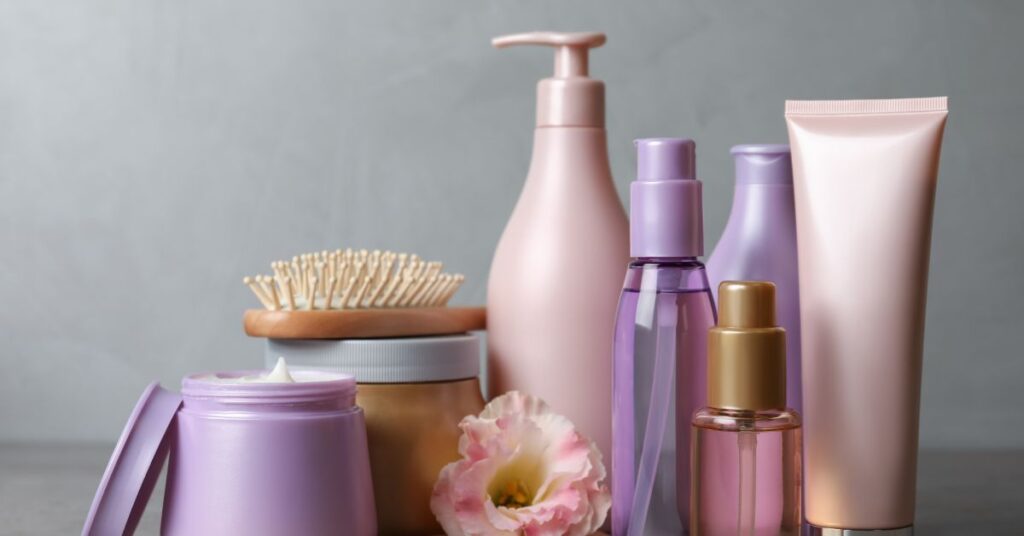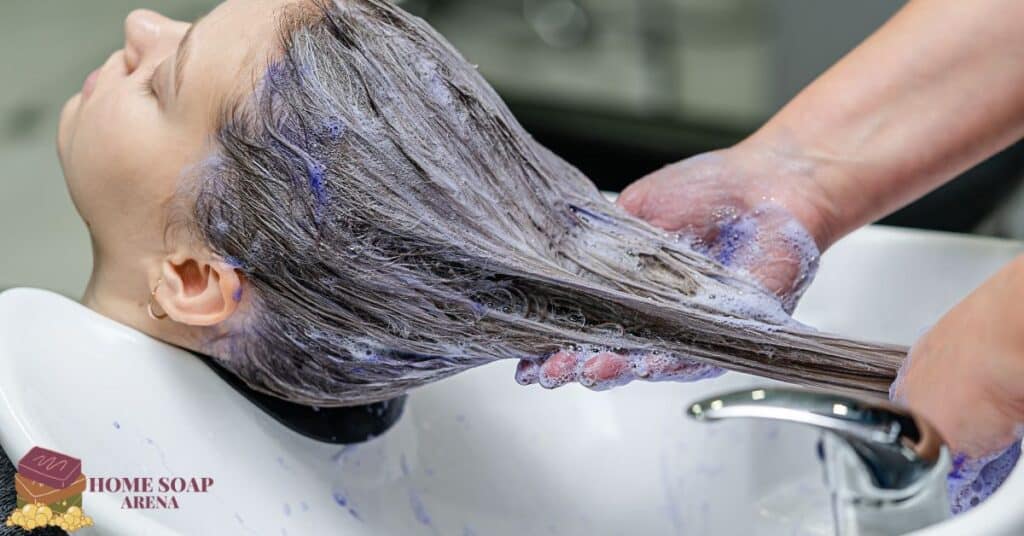Table of Contents
- How Many Hair Products Do You Need?
- Can too many products damage hair?
- Can I use multiple products on my hair?
- Is 3 hair products too much?
- How do I know if I’m using too much hair product?
- What is the best hair care routine?
- Conclusion
How Many Hair Care Products Should I Use? It depends on your hair’s needs.
Hair products, hair length, texture, and health play a significant role in determining your ideal hair care regimen.
When it comes to hair care, the sheer number of products available can be overwhelming.
There are various hair products, like health products and styling products. From shampoos and conditioners to serums and masks, the options seem endless.
The truth is hair only has three basic needs. And once you learn them, you’ll have healthy hair.
Let’s dive into the essentials and extras to help you create a balanced and effective hair care routine.
Let’s start!
How Many Hair Products Do You Need?
People try to tell you you need 20 different products for hair care, but you don’t. You only need a few products that address your hair’s primary needs.
Whether you have dryness, oiliness, or lack of shine, these will be reversed with the right product, routine, and food.
Hair products are divided into hair health products and styling products. So, your goal will determine the products you go for.
Your hair has three basic needs for hair health: cleanse, moisturize, and lock in moisture.
Number one is cleansing. Cleaning the scalp and hair removes dirt and oil and prevents product buildup, scalp issues, and bad smells.
Most of my clients make two colossal shampoo mistakes, which ruin their entire hair routine.
The first is using a shampoo that doesn’t match their hair type. A soulmate shampoo is crucial because if your shampoo is too heavy or too light, it will throw everything off.
The second mistake most of my clients make is misusing shampoo.
When washing your hair, apply shampoo to the scalp, not the length, because that’s where the oil is.
Wash 2-3 times weekly, depending on your hair type and lifestyle. Wash your hair with lukewarm water to protect the valuable cuticle layer.
Overwashing strips your hair of natural oils. Avoid shampoo with artificial additives such as silicones and parabens.
These are deposited on the hair’s surface, and in the long term, they ensure that care substances can no longer penetrate the inside of the hair.
Number two is moisture.
This is where many people get lost on their hair journey because they do not understand moisture.
Regrettably, the majority of moisture products fall short of their intended purpose, as they merely rest on the outermost layer of your hair without being absorbed.
It’s terrible and gross because if it doesn’t absorb into your hair, it just builds up on the outside.
Hair needs internal moisture; products like conditioners and hair masks can help.
For conditioners, the application should focus on the hair length or mids; additionally, enough conditioner should be applied to the hair and let it sit for two minutes to do its job.
3. Lock in the moisture. You need to lock the moisture inside your hair so it doesn’t have a chance to leak out and dry.
Leave-in conditioner changes everything because you lock in that supernatural amount of moisture perfectly sealed in the hair.
Apply your leave-in conditioner to towel-dried hair, not on dry hair. After blow-drying or air-drying your hair, it is time for a Hair serum/tonic or hair oil.
A hair serum is intensive care for your hair. After washing your hair, it is massaged into the damp or already dry scalp.
The active ingredients provide more moisture, protection of the hair structure, and a healthier scalp.
Styling Products
Purpose: Includes gels, mousses, and creams that help shape and hold your hairstyle.
Your desired hairstyle determines the styling product; ensure you choose the correct one. For instance, if you want to blow-dry your hair, a blow-dry cream will do the trick.
Use a thermal protectant for beach waves to protect the hair from heat. The health products serve as a solid foundation, allowing for any styling products to be applied to the hair.
Can too many products damage hair?
Yes, using too many hair products can indeed damage your hair.
While it might seem that more products equate to better hair care, overloading your hair with numerous products can lead to several issues that may harm its overall health and appearance
1. The buildup of products on your hair and scalp can result in:
Limp and Greasy Hair: Excessive product buildup weighs down your hair, making it look flat and oily.
Scalp Issues: Buildup can clog hair follicles, leading to problems like dandruff and inhibiting hair growth. Read more on the causes of dandruff
Reduced Product Effectiveness: Subsequent products may not work well because the buildup acts as a barrier.
2. Dryness and Breakage: Certain hair products contain alcohols, sulfates, and other harsh chemicals that can strip natural oils from hair.
Overusing these products results in dry, brittle hair, leading to itchiness and flakiness.
3. Scalp Irritation: Applying too many products, especially those with synthetic fragrances and chemicals, can irritate the scalp, and some people might develop allergic reactions, causing further scalp issues.
4. Counterproductive Effects: Mixing too many different products sometimes counteracts their benefits.
For instance, ingredients in different products can react negatively with each other, reducing their efficacy or causing adverse effects.
5. Overloading Hair
Heavy use of styling products like gels, sprays, and mousses can stiffen hair and make it difficult to manage.
Can I use multiple products on my hair?
Yes! However, ensure that the multiple products you are using are what your hair needs. There is no point in using various products misaligned with your hair’s needs.
To achieve your hair goals, adopt a routine that will effectively help you reach your desired results.
Is 3 hair products too much?
No! Using multiple hair products isn’t necessarily too much; it depends on your hair type and the results you’re aiming for.
It’s standard to use a combination of products to achieve a desired hairstyle or maintain hair health.
The key is using them in order and quantity to avoid weighing down hair or causing product buildup.
How do I know if I’m using too much hair product?
It is crucial to be conscious of hair product overuse to keep your hair healthy. Here are some signs of potential excess product application:
Residue in Hair: If you notice a film or residue in your hair even after it fully dries, you may have applied too much product.
If your hair appears or feels greasy soon after washing, you might have applied too much hair product or used a product unsuitable for your hair type.
This is especially true for serums, oils, and leave-in conditioners.
Using excessive styling or hair products can make hair stiff, sticky, or excessively soft, making styling difficult.
Overusing hair products may lead to product buildup, diminishing your hair’s natural shine.
Too much product can result in less-defined curls for individuals with curly hair, making it more challenging to manage and style.
Difficulty absorbing moisture is another sign of product buildup. When hair doesn’t seem to absorb moisture as it usually does, it may be due to product buildup.
Lack of Volume: Too much product, particularly heavy creams and conditioners, can flatten your hair and reduce its natural volume.
If your hair looks flat and lacks body, you might be over-conditioning or using too many heavy products.
What is the best hair care routine?
Optimal hair care is a fundamental aspect of daily well-being and involves utilizing products suitable to one’s hair type.
With your hair concerns and goals in mind, this will help you create your routine and choose the right products to achieve your desired results!
Possible haircare goals to pursue include:
- Achieving smooth, shiny hair
- Enhancing volume and texture
- Strengthening, repairing, and hydrating hair
- Increasing color longevity
- Defining waves and curls
- Promoting overall hair health
Every basic haircare routine contains these necessary steps: cleansing, conditioning, moisturizing, detangling, styling, and treatment.
The frequency of these steps will depend on your hair type, lifestyle, and preferences.
- Wash your hair with lukewarm or cold water. Use shampoo that suits your hair type.
Live Love Locks Weightless Shampoo & Conditioner is best for fine and medium hair.
Moroccanoil Moisture Repair Shampoo & conditioner is best for coarse hair and healthy hair.
Redken Cleansing Cream Clarifying Shampoo is best for coarse hair
*I strongly recommend you use Redken on your first wash if you go 5+ days between washes.
- Use conditioner after each wash. Depending on your hair needs, a mask should be used once a month instead of a conditioner.
A mask has an intensive care effect and a longer exposure time.
The frequency of using a hair mask depends on the overall condition of the hair and should be adapted to its needs.
- When your hair is wet, detangle it with a wide-toothed comb. A leave-in conditioner smoothens the detangling process.
- Sometimes, Let your hair air-dry instead of using any heat tools. Secondly, Always make sure you prep your hair before using heated tools.
Use a heat protectant before styling. This will protect your hair from breakage, enhance styling results, and ensure your hairstyle lasts!
- Trim your hair every six months.
- Consider oil massage. Hair oil is a versatile product that adds moisture, controls frizz and prevents dryness.
It’s beneficial even when hair is not freshly washed or after styling. Hair oil helps restore moisture and keeps hair looking healthy and manageable.
Treatment: To give your hair extra strength and length, you can incorporate three types of treatments into your weekly routine: a mask treatment, an oil treatment, and a scalp treatment.
Regular hair treatments will help address specific hair concerns such as damage, dryness, and an oily, flaky, or dry scalp and improve hair’s overall appearance and health.
Conclusion
In conclusion, while it’s tempting to try every product on the market, it’s essential to listen to your hair and give it only what it needs.
Start with the basics, add treatments as necessary, and always pay attention to how your hair responds.
With a little trial and error, you’ll find the perfect hair care routine that works for you.



